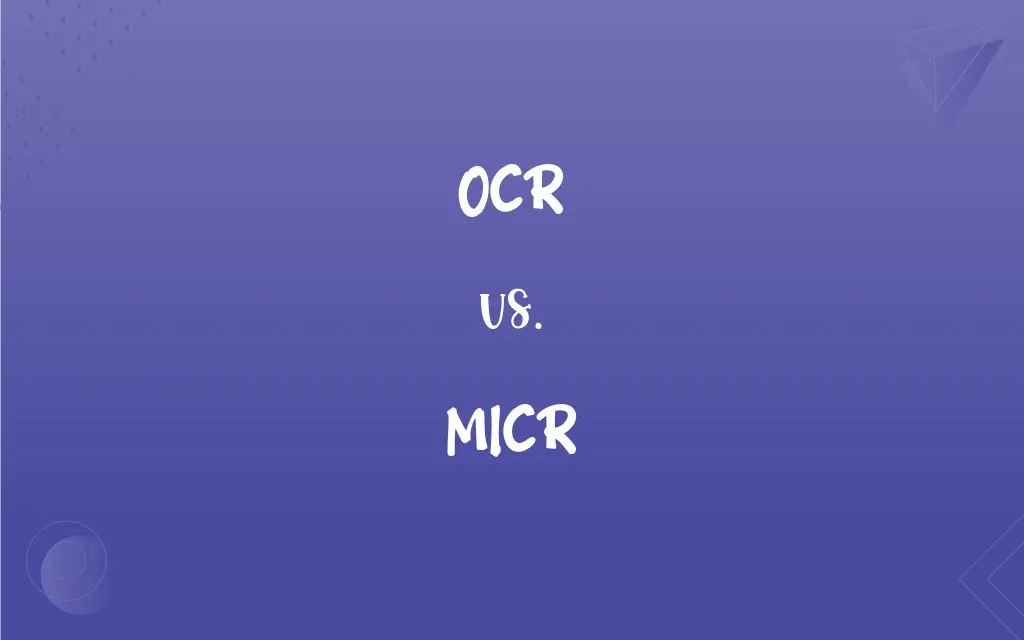OCR vs. MICR: What's the Difference?
Edited by Aimie Carlson || By Harlon Moss || Published on February 21, 2024
OCR (Optical Character Recognition) converts different types of documents into editable and searchable data. MICR (Magnetic Ink Character Recognition) is a technology used to verify the legitimacy and originality of paper documents, especially checks.

Key Differences
OCR technology is designed to digitally recognize and interpret printed or handwritten text characters within digital images of physical documents. MICR, on the other hand, specifically reads characters printed in magnetic ink, primarily used in banking for check processing.
OCR can be applied to a wide range of documents, from scanned paper documents to images captured by digital cameras. MICR, however, is more specialized, focusing on the recognition of a specific set of characters and symbols printed in a unique magnetic ink, typically on bank checks.
The versatility of OCR makes it useful in numerous applications like digitizing printed texts, automating data entry processes, and even in license plate recognition. MICR's use is mainly in the banking sector, where it enhances the security and efficiency of check processing and validation.
OCR software can vary in complexity, from simple text recognition in a single language to complex systems that can recognize handwriting or multiple languages. MICR systems, in contrast, are designed to read only the MICR font, which contains numbers and a limited set of symbols.
OCR has evolved with advancements in machine learning and AI, allowing for more accurate and versatile text recognition, MICR has remained relatively consistent in its design and application, focusing on secure and reliable processing of financial documents.
ADVERTISEMENT
Comparison Chart
Purpose
Converts various document types into digital text
Verifies authenticity of paper documents, especially checks
Usage
Broad applications in document digitization and data entry
Primarily used in banking for check processing
Technology
Digital recognition of printed/handwritten text
Reads characters printed in magnetic ink
Complexity
Varies from simple to complex, including multi-language support
Limited to reading MICR font with numbers and symbols
Evolution
Continuously evolving with AI and machine learning
Relatively consistent in design and application
ADVERTISEMENT
OCR and MICR Definitions
OCR
Enhances accessibility of printed text for screen reading.
OCR enables screen readers to vocalize printed text for visually impaired users.
MICR
Limited to specific symbols and numerals in magnetic ink.
MICR technology is utilized for sorting and bundling checks in financial institutions.
OCR
Recognizes printed or handwritten text in documents.
OCR is used to digitize handwritten historical documents.
MICR
Specialized for banking and secure document handling.
MICR technology is used for quick and secure check clearance.
OCR
Digitizes text from images for editing and searching.
OCR converts scanned pages of a book into searchable text.
MICR
Reads characters printed in unique MICR fonts.
MICR detects specially formatted account and routing numbers on checks.
OCR
Streamlines document management and archival.
OCR is used in libraries to digitize and archive old newspapers.
MICR
Ensures security and efficiency in financial transactions.
MICR reduces fraud risks in check processing at banks.
OCR
Automates data extraction from physical documents.
OCR extracts information from filled-out forms for digital processing.
MICR
Validates authenticity of checks with magnetic ink.
MICR reads the check number and bank code for processing.
FAQs
Can OCR recognize handwriting?
Advanced OCR systems can recognize certain styles of handwriting.
How does OCR work?
It scans and converts text from images into editable and searchable digital formats.
Is MICR used outside of banking?
Its primary application is in banking, especially in check processing.
Can OCR process multiple languages?
Yes, many OCR systems are designed to recognize multiple languages.
Does OCR require specific fonts?
No, it works with a wide range of standard fonts.
Is MICR technology still relevant?
Yes, particularly in banking for efficient and secure check processing.
What is the MICR line on a check?
It's the line at the bottom containing the check number, account number, and bank code.
Can MICR read non-magnetic ink?
No, it's specifically designed to read magnetic ink.
How does MICR read checks?
It reads the magnetic ink characters at the bottom of checks.
What does OCR stand for?
Optical Character Recognition.
What is the main use of MICR?
For verifying the authenticity of paper documents, primarily checks.
Is OCR technology improving?
Yes, with advancements in AI and machine learning, OCR is becoming more accurate and versatile.
Can OCR convert images to text?
Yes, it can convert text within images to digital text formats.
Is MICR exclusive to checks?
While primarily used for checks, it can be used for other financial documents.
How accurate is OCR?
Accuracy varies but has significantly improved with technology advancements.
Why is magnetic ink used in MICR?
For enhanced security and to enable magnetic reading.
What makes MICR secure?
Its use of special magnetic ink and unique fonts enhances security against fraud.
Are there limitations to OCR?
OCR can struggle with poor image quality or highly stylized text.
Does MICR help in automating banking processes?
Yes, it automates and secures the check processing and clearance system in banks.
What industries benefit from OCR?
Libraries, legal, healthcare, and businesses for document digitization and management.
About Author
Written by
Harlon MossHarlon is a seasoned quality moderator and accomplished content writer for Difference Wiki. An alumnus of the prestigious University of California, he earned his degree in Computer Science. Leveraging his academic background, Harlon brings a meticulous and informed perspective to his work, ensuring content accuracy and excellence.
Edited by
Aimie CarlsonAimie Carlson, holding a master's degree in English literature, is a fervent English language enthusiast. She lends her writing talents to Difference Wiki, a prominent website that specializes in comparisons, offering readers insightful analyses that both captivate and inform.







































































